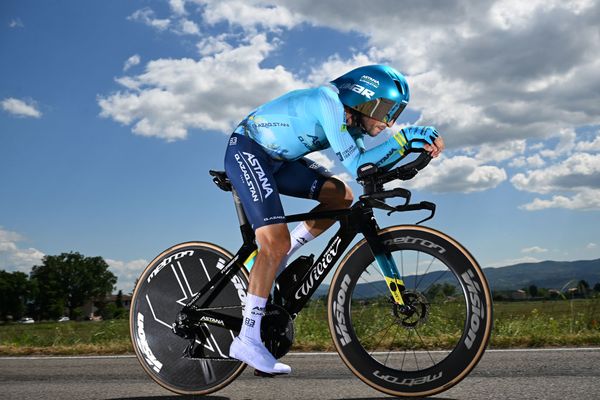7 of the biggest tech flops from Paris-Roubaix over the years
Sometimes Roubaix chews up and spits out seemingly advantageous tech products
Alex Hunt
Junior Tech Writer
Paris-Roubaix is a race unlike any other. Yes, there are other cobbled Classics but none are as demanding on bikes and riders as ‘the Hell of the North’. In the hunt to gain an advantage, competitors of the race have long turned to unique equipment choices, leading to the race's long history of technological innovation.
Some have proven pivotal, such as Specialized’s Roubaix or Trek’s Domane which both have victories attributed to their use. Not every piece of Roubaix tech proves to be an advantage, though. The race is full of examples of times the race chewed up and spat out promising tech developments.
Here we look at seven of the most notable tech fails of the cobbled Monument.
RockShox Paris Roubaix SL suspension fork
Starting off the list of flops is something that, at the time, was anything but a flop. Although first used in 1991, the RockShox Roubaix SL fork claimed its first victory at the race the following year, before backing this up with further victories in 1993 and 1994. By this point, it really did look like the suspension fork had changed the game at Paris-Roubaix, however, riders soon turned their back on the fork in the years that followed, leaving the Roubaix SL fork to gather dust.
Pinarello K8-S rear suspension

© GCN
The Pinarello K8-S was only briefly tested at Paris-Roubaix
In 2015, Pinarello took a crack at adding suspension to a road bike, however this time it was at the rear of the bike. The K8-S used a small elastomer damper unit between the seatstays and seat tube to offer up to 10mm of rear wheel travel. There was no lower pivot for the rear triangle to actuate around and the brand instead relied on the vertical flex in the carbon. Unlike the RockShox Roubaix SL, the K8-S never claimed the top step of the podium and was subsequently superseded by the regular Dogma used by Team Sky, and later Ineos Grenadiers.
Lampre-Merida turn to disc brakes
It's hard to imagine a time when disc brakes didn’t dominate the peloton but you only have to go back eight years to 2016 to find a very different landscape. Disc brakes were in a trial period with many riders unhappy about their introduction.
At that year's edition of Paris-Roubaix, the team of Lampre-Merida announced that they would be using the newly released Merida Scultura Disc for the race, sparking outrage. This wasn’t helped when a mid-race pileup on a section of pavé left Movistar’s Francisco Ventoso with a deep laceration that he blamed on a disc brake.
After the race, Ventoso wrote an open letter to the UCI asking for disc brakes to be banned, although he did not get his way, this did delay the approval of the technology. The story finally reached its conclusion after the World Federation of Sporting Goods commissioned a forensic investigation into the incident, and it transpired that the laceration had in fact been caused by a chainring, not a disc brake as suspected.
George Hincapie’s aluminium steerer tube
Carbon fibre took its time to be accepted as a suitable material for Paris-Roubaix, as many teams and riders were reluctant to move away from the tried-and-tested aluminium products they had grown accustomed to. In 2006, George Hincapie found that aluminium wasn’t immune from issue after he ended up on the floor after his steerer tube snapped whilst he was navigating a sector of pavé. Although the bike he was using was made of carbon fibre, his fork steerer was made of aluminium. After the race, Trek claimed that the failure was a result of damage suffered in a crash earlier in the race.
Self-inflating tyres
Paris-Roubaix is a technical headache when it comes to tyre pressures and bike set-up. Although the race is often decided over the 29 sectors of pavé, there is the not-so-insignificant matter of over 200 kilometres of tarmac to navigate between the start and the finish in the Roubaix Velodrome. This means that riders are forced to make a compromise and balance rolling efficiency with grip and control.
In recent years, some teams have toyed with the idea of using adjustable tyre pressure systems that allow them to increase and decrease the pressure of the tyres on the fly. This technology looked to provide a solution to a very real problem however come race day teams strayed away from using and it has never had the breakthrough that it looked destined for.
Specialized Future shock

© GCN
The Future shock system wasn't popular among pro riders
Since its release, the Specialized Roubaix has claimed more victories at the race it was named after than any other bike. In 2017 the brand revealed a new generation of the Roubaix that used a steerer-based suspension unit to provide 20mm of travel to the riders. The issue with this system was that a lot of the professional riders were not a fan of the Future shock system. This led to pre-race favourite Nikki Terpstra using a modified Roubaix that replaced the Future shock with a solid aluminium block.
Unfortunately, this modification failed in the race and as a result of this he crashed out. After the race, Specialized claimed that this was due to the modification being in its prototype pre-production stage. The fact that the professional riders did not want to use the Future shock solidifies its place in Roubaix tech flops.
Automatic chain lubing
No matter the weather, the pavé of Paris-Roubaix always tests bikes to their limits. Nowhere is this more the case than the drivetrain. At 260 kilometres in length, it is hard to keep a chain lubricated at the best of times, but if you throw in dust or mud, the chain can quickly run dry.
In an aim to solve this issue, Scottoiler released the S1 automatic chain lubricator. This aimed to continually apply lubricant to the chain to prevent this from happening. The unit was powered by two AAA batteries and could hold enough lubricant for up to 52 hours of riding.
Caleb Ewan trialled the system however it never made it to the start line of Roubaix with teams deeming the weight penalty and potential gains it provided not significant enough to warrant its use. With most teams now using a wax lubricant rather than an oil-based lube, the issue the S1 aimed to solve has been more elegantly resolved through the natural properties of the wax not attracting dirt or contamination.















.jpg?w=600&auto=format)